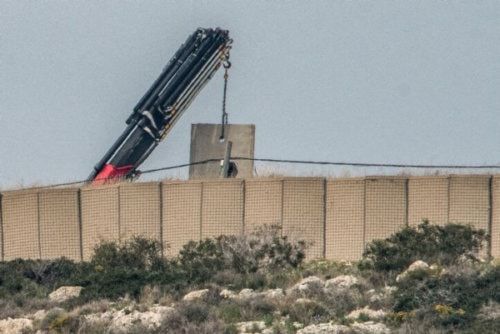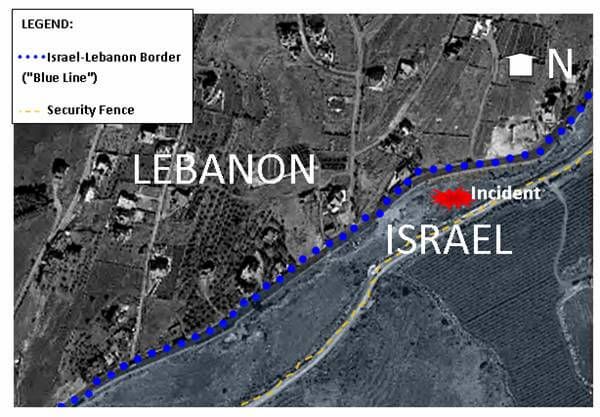 Australia’s national broadcaster ABC News reports from the Lebanese border where Israel is constructing a security wall.
Australia’s national broadcaster ABC News reports from the Lebanese border where Israel is constructing a security wall.
It appears, however, that Middle East correspondent Adam Harvey is only prepared to acknowledge the views from one side of the wall and even then to selectively omit important political, historical and geographical context.
We’ve had significant issues in the past with Harvey’s predecessor Sophie McNeill, an advocacy journalist who consistently demonstrated an anti-Israel agenda. Is ABC News continuing its trend for sub-standard reporting on Israel?
It certainly looks that way.
No comment from the Israeli side
It soon becomes clear that Harvey hasn’t done any research or asked for any commentary from the Israeli side of the border. Harvey only quotes a Lebanese man who lives near the border, and a UNIFIL spokesman. No Israelis. In the course of a 3:21 radio spot amounting to 631 words, these 23 words are the sum total of the Israeli view:
Israel says the $600 million project is essential to stop Hezbollah fighters from attacking Israelis in the villages and settlements near the border.
The rest of the report is devoted to commentary from one local Lebanese man and Andrea Tenenti, the spokesman for the United Nations Interim Force in Lebanon (UNIFIL).
According to the local man, “the threat of incursion is from Israel.” Had Harvey bothered to get comment from an Israeli source, perhaps he would have noted which side is really threatening the other.
As The Times of Israel reported:
The concrete barrier is designed to serve two main functions: protect Israeli civilians and soldiers from sniper attacks, and prevent infiltration into Israel by Hezbollah operatives.
According to the senior officer, approximately seven years ago, Hezbollah began creating a special forces unit — known as the Radwan Unit — specifically tasked with crossing into Israel and causing as much mayhem and destruction as possible both for the sake of the destruction itself and for the “symbolism” of having troops carry out attacks inside Israel.
“Their main goal is to kill as many people as they can in [Israeli] villages and army bases,” the officer said.
Hezbollah has threatened to capture the Galilee using tactics it learned in Syria. Moreover, the IDF also has presented evidence that Hezbollah is hiding behind an environmental NGO (non-governmental organization) to gather intelligence along the border.
Indeed, Hezbollah is the central reason for the construction of a border barrier yet the one line of 23 words above referencing “Hezbollah fighters” is the only time that this deadly terrorist organization warrants a mention. How is it possible that the entire context for the building of this wall has been reduced to this?
Why no mention that Hezbollah is an Iranian proxy with thousands of rockets trained on the entirety of Israel? Why no mention of the constant threats made against Israel by Hezbollah leader Hassan Nasrallah?
Presenting only one side of a story is a form of imbalanced reporting (learn more about it). Misrepresenting fringe views as mainstream or giving a topic disproportionate coverage are other forms of imbalanced reporting.

Israel equally responsible for a violent border incident?
Instead, according to the ABC, Israel is, at best, equally responsible for violence as the other side.
Referring to the UN-demarcated border, the report states:
There are regular breaches of the Blue Line, often by Lebanese shepherds or Israeli drones, and in 2010 both sides started shooting at each other over what began as a dispute surrounding an overhanging tree branch and an Israeli fence.
And UN spokesman Andrea Tenenti is quoted by the ABC:
There was a branch of a tree on top of the technical fence, which the IDF wanted to cut and the Lebanese did not agree, so during the discussion when the IDF started cutting the tree shooting started and four people got killed.
Shooting did not start on both sides. Only one side started shooting.
Lebanese forces opened fire on IDF soldiers performing routine maintenance work by the security fence near the border. The IDF soldiers were clearing bushes to improve the line of sight over the border and to prevent Hezbollah terrorists from hiding in the undergrowth and carrying out an attack or kidnapping. As confirmed by the UN itself, the routine work had been cleared in advance with UNIFIL.
In addition, while ABC’s listeners and readers may be led to believe that this was an incident on or over the Blue Line, it is vital to note that the UN-demarcated official border between Israel and Lebanon does not always follow the route of the security fence. While the IDF was operating over the fence, it was still within Israeli territory as was also confirmed by the UN.

Both Harvey and Tenenti have offered a misleading version of the event that turns Israel into the aggressor rather than the victim. Even Tenenti’s bosses acknowledged Israel’s version of events back in 2010.
Ghajar: A village’s missing context
But that isn’t the only historical or geographical context missing from the report, which then focuses on the village of Ghajar:
It will get more complicated later if Israel tries to extend its wall through Lebanese territory that it currently occupies — like at the village of Ghajjar.
“Ghajjar is a village that is divided in two by the Blue Line,” Mr Tenenti said.
“The northern part of the village of Ghajjar has to go back to Lebanon. Israel is obliged to withdraw from the northern part of the village.
“Several proposals were sent to the parties. The Lebanese have accepted the proposals, in principal the Israelis also but so far there has been no movement in that village, so part of that village is still under occupation.”
Ghajar is a highly complex issue that cannot be adequately tackled in such a superficial way (see HonestReporting’s explainer). Firstly, the village itself is actually located on the border of Israel, Lebanon and what was pre-1967, the Syrian Golan Heights. The ABC report fails to mention the history of the village as outlined in a feature article from Time magazine in 2015:
In 1967, Israel conquered the Golan Heights from Syria and those Ghajar residents who remained later chose to accept Israeli citizenship when the territory was annexed in 1981. In 1982, when Israel occupied southern Lebanon, the village expanded into Lebanese territory. When Israel pulled out of southern Lebanon in 2000, the residents in northern Ghajar suddenly found themselves living in Lebanon, whilst their relatives and neighbours who previously lived just across the street now lived in a separate country — and an enemy state.
Time refers to the proposed division of the village:
The residents are opposed to the division. “We are not Lebanese, we don’t have any links to Lebanon”, says Khatib. If the village was transferred into Lebanon’s hands, the locals, he says, would become “refugees”.
For years, Khatib and others have been holding protests and demonstrations against any change to the village boundaries. Khatib says he has lobbied everyone from former U.N. Secretary General Kofi Annan to successive Israeli Prime Ministers on this, delivering “stacks of plans , maps and building permits all to show that Ghajar is not Lebanese”.
ABC doesn’t tell you that the residents of Ghajar were opposed to any handover of Israeli authority to the UN. It also doesn’t tell you why any movement to implement this handover has stalled, including issues such as the de facto takeover of the Lebanese government by Hezbollah and the instability on the Syrian border near Ghajar as a result of the Syrian civil war.
Context describes the conditions in which something happens. Without a frame of reference for readers, journalists can dramatically distort the true picture — in this case, Ghajar. (Learn more about the journalistic problems raised by lack of context.)
* * *
Ultimately, Adam Harvey and ABC have stripped and condensed a multifaceted and complex story, instead presenting it as two sides of a large wall.
Unfortunately, Harvey failed to look over the wall and present the Israeli side.
Please contact ABC News through its online complaint form – https://www.abc.net.au/contact/complain.htm




